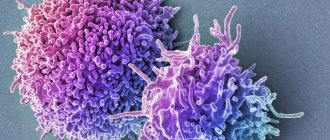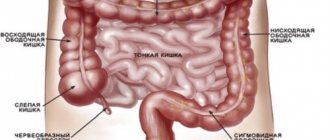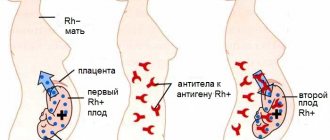The anatomical structure of the pancreas (PG) ensures its versatility: it is a key organ of the digestive and endocrine system. Pancreatic hormones ensure metabolic processes, digestive enzymes ensure normal absorption of nutrients. Not only the development of pancreatitis or diabetes mellitus, but also diseases of the stomach and intestines, as well as the ability to quickly adapt to changing external and internal factors depends on the condition of this organ.
What is glucagon and its role in the body
Glucagon is a peptide hormone that is produced to maintain appropriate blood glucose levels. Research shows that it prevents blood glucose levels from getting too low.
This is done through a process called glycogenolysis, which occurs when glucagon in the liver stimulates the conversion of stored glycogen into glucose. It is this process that allows the body to maintain adequate plasma glucose concentrations.
Research shows that glucagon is secreted from the alpha cells of the pancreas in response to:
- hypoglycemia
- long-term fasting
- physical exercise
- eating high protein foods
When you fast for an extended period of time, this important protein promotes the use of stored fat for energy, which maintains the body's glucose consumption.
What regulates glucagon, its interaction with insulin
Other substances
There are other pancreatic hormones that perform important functions in the body. Quite often, doctors have to determine the concentration of the following substances:
- Lipocaine – promotes the production of fats and the oxidation of fatty acids. It also protects the liver from developing fatty degeneration.
- Vagotonin – helps to increase the tone of the vagus nerve, which has a positive effect on the functioning of all internal organs.
- Centropnein is a component that activates the respiratory function, promotes relaxation of the bronchial muscles, it is responsible for the connection of hemoglobin with oxygen and its transportation.
- Thyroliberin - is responsible for the production of thyroid hormones in women who have given birth.
It is very important to know the role and functions of pancreatic hormones, this helps to prevent the development of complications.
https://youtu.be/YUIO8E5tTwE
How glucagon works with insulin
Glucagon and insulin are two hormones that work together to control blood sugar, but they have opposite effects.
Glucagon is released when blood sugar levels become too low, and insulin is released when blood sugar levels become too high.
In case of hypoglycemia, glucagon release is stimulated in order to correct the imbalance. This can happen when a person fasts for a long period of time or when they eat a lot of protein foods.
Related articles:
- Alanine - effect on the body
- Increased Insulin Resistance - The Ultimate Guide
Insulin, on the other hand, is stimulated during hyperglycemia, when blood sugar levels are too high. Insulin signals cells to take in glucose from the blood to use as energy. When cells take up glucose, blood glucose levels decrease.
Any excess glucose is stored in the liver and muscles as a substance called glycogen. The body uses glycogen for energy between meals.
Glucagon regulates the conversion of glycogen to glucose when blood sugar levels become too low to maintain this important balance.
The body determines which hormone is needed to maintain blood sugar balance. Research shows that glucagon release is prevented when blood glucose levels rise and after eating a high-carbohydrate meal. On the other hand, the hormone is released after a high protein meal.
Insulin also plays a role in this balance—its release occurs after a high-carbohydrate meal and is prevented after a high-protein meal. Glucagon and insulin act throughout the day to regulate blood glucose levels and energy reserves.
Glucose metabolism disorders
Impaired glucose metabolism occurs when the body is unable to process sugar into energy. People need to maintain normal blood sugar levels to nourish the central nervous system.
The most common condition that interferes with the body's ability to maintain normal blood glucose levels is diabetes.
Insulin and glucagon are not produced or released properly in diabetics. This can lead to dangerously high blood glucose levels.
There are several types of diabetes that affect insulin and glucagon levels, including:
- Type 1 diabetes: A less common form of diabetes in which the immune system destroys the cells that produce insulin, so the hormone is not produced by the body itself and must be taken externally. Type 1 diabetes usually causes more severe diabetes symptoms, and symptoms usually develop earlier and at a younger age than type 2 diabetes.
- Type 2 diabetes : This is when your body produces insulin, but your cells don't respond to it properly. Type 2 diabetes causes high blood glucose levels because insulin cannot take it out of the blood for energy.
- Prediabetes: Symptoms of prediabetes occur when blood glucose levels are above normal but below a certain threshold for diabetes. It is considered a "risk condition" and can usually be prevented through lifestyle and diet changes. Prediabetes is also preceded by metabolic syndrome and insulin resistance.
- Gestational diabetes : Diagnosed between 24 and 28 weeks of pregnancy and occurs when a pregnant woman's blood sugar levels are too high.
Two situations that can occur when the hormones insulin and glucagon do not function properly:
Hypoglycemia . Low blood glucose can result from fasting, excessive exercise, and people with diabetes inadvertently taking too much insulin or glucose-lowering medications. Signs of hypoglycemia include:
- hunger
- restlessness and trembling
- sweating
- dizziness
- headache
- muscle weakness
- brain fog
Hyperglycemia . High blood glucose occurs when the body does not produce enough insulin or cannot use it properly. This occurs in diabetic patients and people with hormonal imbalances. Symptoms usually include:
- increased thirst
- frequent urination
- problems with concentration
- blurred vision
- headache
- weakness
- numbness of the limbs.
Diagnostic methods
Violation of the production of one or another hormone of the pancreatic gland can lead to various pathologies affecting not only the pancreas, but also other internal organs. In such cases, the help of a gastroenterologist is required, who, before prescribing a course of therapy, must conduct a diagnostic examination to make an accurate diagnosis. Below are the most common procedures performed for pancreatic dysfunction.
Diagnosis of pancreatic diseases
Table. Diagnostic studies of the pancreas.
| Procedure name | Description |
| Ultrasound examination is one of the most popular and effective methods for diagnosing pathologies of the pancreas and other internal organs. It can be used to identify tumors, cysts, the appearance of stones or the development of an inflammatory process. | |
| During endoultrasonography, pancreatic tissue can be examined for pathological changes. Also, using this procedure, the doctor examines the lymph nodes, if necessary. | |
| An effective way to diagnose the pancreatic gland, since computed tomography can detect possible atrophic processes, pseudocysts and various neoplasms. | |
| During this procedure, a microscopic examination of pancreatic tissue is performed. With its help, you can identify the inflammatory process and determine whether a malignant or benign formation has arisen in the organ under study. | |
| Based on the results of the tests, it is possible to determine the level of amino acids, direct bilirubin, seromucoid and other substances that indicate the development of a particular disease. | |
| During a laboratory examination of stool, the doctor may identify particles of starch, fat, muscle fibers or fiber - all this indicates a disruption of the pancreas. |
On a note! In addition to the above diagnostic methods, the doctor may prescribe another procedure - a biochemical blood test. Unlike a general analysis, a biochemical blood test allows not only to determine possible infectious diseases, but also their type.
Using Injectable Glucagon
Our bodies produce glucagon naturally, but there is also a synthetic version that is available as a prescription medication.
Glucagon injections are sometimes necessary in severe cases of hypoglycemia. Injectable glucagon kits are available for patients with diabetes if they lose consciousness as a result of a severe reaction to insulin, or for people with an unusual case of deficiency in glucagon secretion.
The emergency kit usually contains lyophilized glucagon in powder form, which can be used as an injection in a one-milliliter diluent syringe. The powder contains one unit of glucagon, which is 1 milligram, and 49 milligrams of lactose. Before injection, the medicine is mixed with a diluent.
The effect of glucagon injection is limited. A person suffering from severe hypoglycemia will need to consume carbohydrates as soon as he or she is able to do so to maintain blood sugar balance.
Dosage
One unit of glucagon usually contains 1 milligram, which is the recommended dose for adults and children weighing more than 20 kg with hypoglycemia. Children weighing up to 20 kg should receive 0.5 units, which is 0.5 mg of glucagon.
Another common dosage recommendation is 20-30 micrograms per kilogram of body weight.
Glucagon units can be administered via a rescue kit intravenously, intramuscularly, or subcutaneously.
Following a hypoglycemic episode requiring glucagon administration, the healthcare provider should be notified and glucose levels monitored until they are restored.
Risks, side effects and interactions
Side effects of glucagon may include nausea and vomiting. However, these are also symptoms of hypoglycemia for which synthetic glucagon can be used.
In rare cases, glucagon medications may cause allergy symptoms such as rash, itching, breathing problems, and low blood pressure.
For people with conditions that prevent their liver from producing glucose properly, taking glucagon will not be effective. This may include patients with adrenal insufficiency and chronic hypoglycemia.
In these cases, oral glucose may be more effective.
The body may produce too much glucagon, which is caused by a rare tumor in the pancreas called glucagonoma.
Excessive glucagon can cause health problems such as:
- diabetes
- thrombosis
- skin rash
- weight loss.
Glucagon interacts with certain medications, particularly anticoagulants such as warfarin. Patients who must take the hormone to lower blood pressure while using anticoagulants should be under the supervision of a physician.
The safety of glucagon during pregnancy and breastfeeding is unclear, but the risk to the unborn fetus is considered low.
Conclusion
- Glucagon is a peptide hormone that works together with insulin to maintain normal blood sugar levels.
- This hormone is released when blood sugar levels become too low. It triggers the conversion of stored glycogen into glucose, which can then be used by the body as fuel.
- For people with hypoglycemia, glucagon injections can be used to immediately regulate blood glucose levels. This is usually used for serious emergencies.
- The best way to eliminate low blood sugar in normal situations is to eat foods high in carbohydrates.
Pharmacological action of pancreatic hormone
An analogue of a natural hormone is obtained using genetic engineering or a peptide of animal origin is used. This drug “Glucagen” has the same properties as the natural hormone: it increases blood sugar, activates blood circulation in muscle tissue, inhibits contractions of the walls of the stomach and intestines, and relieves spasms of the digestive organs.
The pharmacological effect (glycogen breakdown) appears 5-10 minutes after injection into a vein; 15 minutes are necessary to increase the concentration of glucose when administered intramuscularly. If you administer Glucagon subcutaneously, the first results will appear only after half an hour. The high sugar level after the injection lasts for about an hour and a half.
The effectiveness of the drug depends on how much glycogen is available in the liver. Therefore, in patients who were fasting or on a low-calorie diet, there was no increase in glucose. It is also inadvisable to administer it in case of chronically low sugar due to adrenal insufficiency, tumor (insulinoma), or alcoholism.











